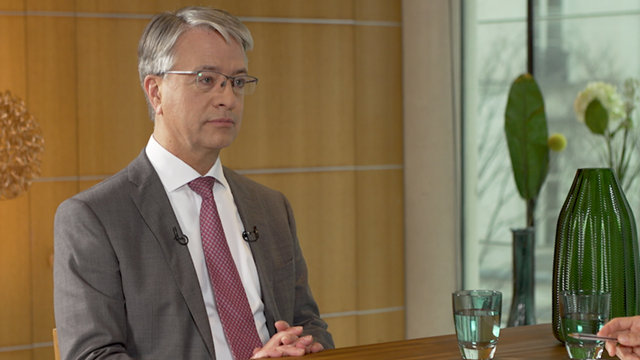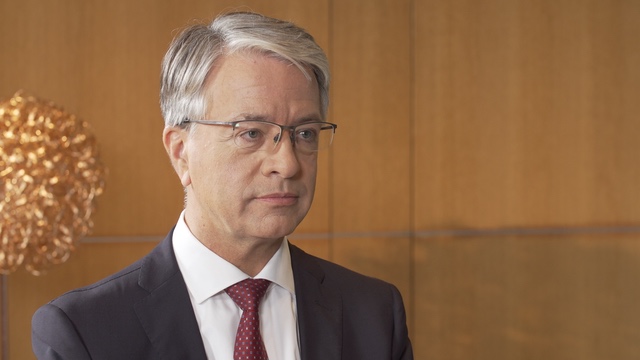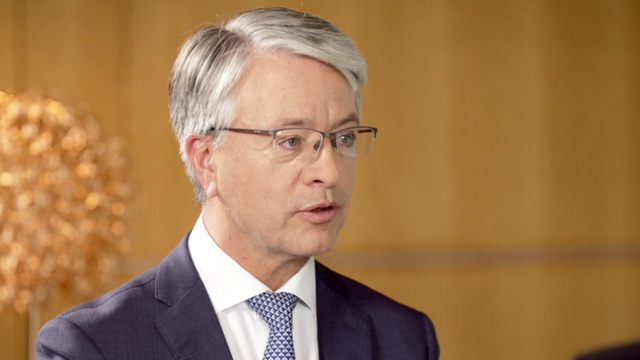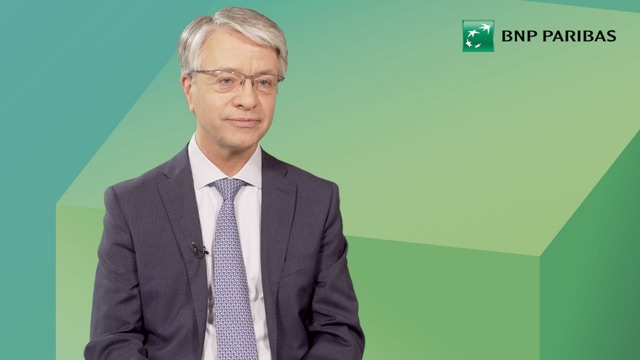EuroBusiness Media (EBM): BNP Paribas, one of Europe’s largest banks, reports earnings for the 3rd quarter of 2009. Baudouin Prot welcome. You are the CEO of BNP Paribas. What are your comments on the Group's performance in the 3rd quarter? In particular, given that the results for both you and your peers were so strong in Q3, what are the reasons for satisfaction, and for concern, with this set of results?
Baudouin Prot (BP): The results confirm the trends of the first half of the year and the key position that BNP Paribas now occupies in its core businesses and markets, in an environment where the cost of risk is starting to plateau at an elevated level and the capital markets are more normalised. At an operating level, BNP Paribas delivered a strong operational performance in all businesses, with good revenue growth at +14% compared to the same quarter last year. For the first time since the beginning of the crisis the cost of risk is slowing down, up only +2% compared to 3Q08 and even down quarter on quarter. Excluding BNP Paribas Fortis and the corporate centre the profit before tax is over 2bn euros, up +76% compared to the same quarter last year and even slightly up compared to the strong 2Q09, in spite of the usual seasonal effect.
This allowed the Group to post a net profit in the quarter of 1.3bn euros.
This performance was achieved while maintaining a sustained effort to finance our clients and the economies we operate in, notably Belgium, France, Italy, and Luxembourg, but reducing further our exposure to market risks. As a consequence, the Tier 1 ratio reached 10% pro forma of the repurchase of non-voting shares and the rights issue, the highest level ever. These results are confirming that BNP Paribas is well positioned to grow organically while maintaining a solid earnings capacity.
EBM: In retail banking, given that net interest margins are low across Europe, and even lower in France, what is your outlook for this part of your business?
BP: The revenues of BNP Paribas's main retail banking businesses in the Eurozone (French Retail Banking, BNL bc and Personal Finance) have all progressed well this quarter despite the low interest rate environment.
France with a +4.1% revenue growth outpaced the two previous quarters thanks to a good momentum in loans outstanding and a positive shift in the deposit mix as the drop in interest rates prompted clients to move their savings from market rates products towards better-margin mutual funds or life insurance products. Net interest income therefore grew by 5.3% compared to the third quarter of last year. BNL bc boasted a +3.8% revenue growth / 3Q08 close to previous quarters' growth, when BNL outperformed most of our Italian competitors. Net interest income is under pressure but BNL bc benefited this quarter from good loan growth, a better deposit mix and also customer gains in the quarter. Personal Finance managed to grow revenues double digit (+11.2% / 3Q08), it is the only retail business which benefits from lower interest rates.
EBM: Can you elaborate on the cost of risk for your different businesses? When do you think that we'll reach the peak for credit delinquencies in retail banking?
BP: The crisis was marked by three periods: first the financial crisis, with large impairments on market counterparties, then the economic crisis with a rise in loan loss provisions, and now a stabilisation. In the third quarter the cost of risk in CIB declined on both capital markets and financing activities, while it continued to rise in retail banking, with the notable exception of the French retail network. It is however always difficult to extrapolate from a single quarter's performance. At group level we have already reached a sort of plateau. We now expect to remain at a high level of cost of risk for some time. We do not anticipate any dramatic improvement. I expect the Group to continue to outperform its peers business by business, in terms of NPL generation and cost of risk. Fortunately, the considerable achievements made in operating efficiency have blunted part of the effects of this high level of cost of risk. Over the first 9 months of 2009, Gross Operating income rose by 4.5bn euros fully offsetting the 3.3bn euros rise in cost of risk.
EBM: Given what you've just told us about the environment, are you still as confident today about Fortis?
BP: Yes, we are confident in the quality of the franchise we have acquired in Belgium and Luxembourg and in our ability to extract further value out of it. The current environment is anything but a surprise. This quarter again, Fortis contributed significantly to the group's performance with a pre tax income of 575m euros. If we shave off 320m euros of PPA adjustment this quarter, this puts the underlying businesses contribution at 255m euros - well above initial breakeven anticipations. The integration project is proceeding well and a complete update will be provided to the market at our upcoming investor day on December 1st.
EBM: At a time when several competitors have decided to downscale or dispose of their asset management businesses, could this present an opportunity for BNP Paribas to increase its footprint in asset management, notably through acquisitions?
BP: Asset management is a core business for BNP Paribas that has performed well over the crisis, proving its resilience especially as regards net asset inflows and pre-tax profit. Through the acquisition of Fortis Investments, we have just added more than 160bn euros to our asset management business. We are now within the top 5 players in Europe, with a franchise strengthened after the crisis, and we are determined to keep on running our business efficiently.
EBM: Your corporate and investment banking franchise is seeing record revenues as well as record return-on-equity. How sustainable do you think this is?
BP: CIB posted again this quarter very good performances, in spite of the seasonal effect, thanks to a sustained client business and a sharp drop in the cost of risk. This strong performance reflects the leading positions in Europe and improved market conditions.
Revenues were up +43% compared to 3Q08, which was marked by the financial crisis. The pre-tax income reached 1,2bn euros, a particularly high level. This was accompanied by a further significant reduction of market risks, evidenced by a decrease by 30% in the value at risk. This confirms the client-centric business model of our CIB business.
EBM: Assuming a normalized 8bn euros net profit per year for BNP Paribas, of which about half gets paid out in dividends, that leaves roughly 4bn euros of earnings per year against about 600bn euros of risk-weighted assets for the Group. Using this "back-of-the-envelope" calculation, would it be fair to assume that BNP Paribas can increase its core Tier One ratio organically by about 70bp per year?
BP: Well I wouldn't want to give any form of guidance on full year earnings in this environment, let alone a normalised run rate for the coming years. Let me also remind you that our dividend payout ratio has always been significantly below 50% notably to allow for the financing of our organic growth. In this year's challenging environment, BNP Paribas posted a net profit of 4.5bn euros over the first nine months. Over this period the organic capital generation represented 65bp out of the 220bp total increase in the Tier 1 ratio. The largest share of the rise in this ratio originated from the decrease in risk-weighted assets, ie a positive impact of over 100bp thanks to the reduction of risks in CIB and Fortis Merchant banking. BNP Paribas will continue to generate organic capital via retained earnings over the coming quarters and years, which will be used to finance organic growth, and the latter will no longer be offset by the de-risking of CIB, which is now over. You should therefore not expect the capital generation to translate into an increase of the Tier 1 ratio. At 10% the current level of this ratio is very comfortable given the diversified business model of the Group.
EBM: Given the buoyant state of the financial markets, at what point do you think the time will come for write-ups of toxic assets?
BP: Let me remind you that BNP Paribas entered the crisis with a limited exposure to toxic assets compared to its peers, which explains its remarkable resilience in the first period of the crisis, the financial crisis.
As for Fortis, the most toxic structured credit assets were ring-fenced in a specific portfolio, and the rest was booked in BNP Paribas' balance sheet at their fair value, in the banking book. Therefore no write-ups will be posted in the future, but the discount to the nominal value will be amortised until the maturity of the assets. Therefore, even if the credit market improves further, BNP Paribas will not book material write-ups.
EBM: Despite a tougher regulatory environment for banks post-crisis, the market still seems to think that 15% return on equity is the kind of return that should be expected by banks such as BNP Paribas. Is this an appropriate or fair assessment of the situation in your view?
BP: BNP Paribas posted a post tax ROE of 11% over the first nine months of the year in a challenging environment with the high cost of risk still weighing heavily on profits. In the coming quarters, market share gains and higher attractiveness of BNP Paribas franchises as well as its integrated and diversified business model should help the Group maintain robust profits. All in all, taking into account the tougher regulatory environment, implying higher capital base, I think a 15% target is still challenging. I think that this is the ROE the Group should nevertheless strive to achieve on average across the cycle. But bear in mind that this is across the cycle and this is anything but an average credit environment.
EBM: What do you respond to those who fear that you may have raised too little capital in your recent rights issue, especially if regulatory solvency ratios were to be increased in the not-too-distant future ?
BP: When we announced the rights issue we said that 4.3bn euros was adequate because of the capital-generating capability of the Group. This is proven right by the third quarter results we are announcing today. Too much capital would be a burden, it would weigh on EPS and dividend growth as well as return on equity. In 2009, BNP Paribas has increased its Tier 1 ratio by a full 2.2pt, taking it to 10% pro forma of the repurchase of the non-voting shares and the rights issue. This is very comfortable to absorb the future incremental capital requirements and finance the future organic growth, given that the Group will continue to organically generate capital.
EBM: At the recent G20 summit, we have heard a lot of talk regarding the need for banks to increase capital ratios. BNP Paribas's core tier 1 capital ratio is around 8%, in line with the core tier 1 of its peers. Does BNP Paribas need to raise its core tier 1 capital ratio well above its current level, in order to comply with new capital requirements regulations? If so, how much more do you need and where is the additional capital to come from?
BP: Regulators do take into account, when they set minimum capital requirements for each bank, the business model, the capital generation capability, the risk profile and diversification of the bank. The minimum capital requirements for BNP Paribas are therefore below those of most of our peers. This was vindicated by the track record in terms of profit and capital generation over the crisis. Thanks to the smaller proportion of market risks in BNP Paribas' total risk-weighted assets compared to its peers with significant CIB business, the impact of the new capital requirements for market risks is likely to be smaller. At 7.8% pro forma the equity Tier 1 ratio is very comfortable to absorb the incremental capital requirements from market risks, to be implemented end of next year, and finance the organic growth.
EBM: Baudouin Prot, CEO of BNP Paribas, thank you very much.
BP : You’re welcome.






